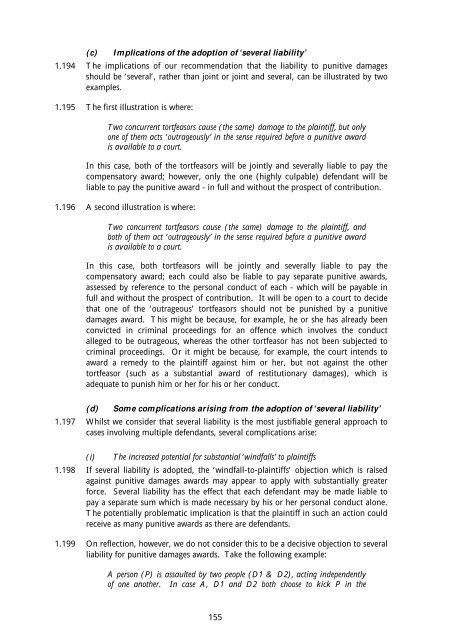Aggravated, Exemplary and Restitutionary ... - Law Commission
Aggravated, Exemplary and Restitutionary ... - Law Commission
Aggravated, Exemplary and Restitutionary ... - Law Commission
Create successful ePaper yourself
Turn your PDF publications into a flip-book with our unique Google optimized e-Paper software.
(c) Implications of the adoption of ‘several liability’<br />
1.194 The implications of our recommendation that the liability to punitive damages<br />
should be ‘several’, rather than joint or joint <strong>and</strong> several, can be illustrated by two<br />
examples.<br />
1.195 The first illustration is where:<br />
Two concurrent tortfeasors cause (the same) damage to the plaintiff, but only<br />
one of them acts ‘outrageously’ in the sense required before a punitive award<br />
is available to a court.<br />
In this case, both of the tortfeasors will be jointly <strong>and</strong> severally liable to pay the<br />
compensatory award; however, only the one (highly culpable) defendant will be<br />
liable to pay the punitive award - in full <strong>and</strong> without the prospect of contribution.<br />
1.196 A second illustration is where:<br />
Two concurrent tortfeasors cause (the same) damage to the plaintiff, <strong>and</strong><br />
both of them act ‘outrageously’ in the sense required before a punitive award<br />
is available to a court.<br />
In this case, both tortfeasors will be jointly <strong>and</strong> severally liable to pay the<br />
compensatory award; each could also be liable to pay separate punitive awards,<br />
assessed by reference to the personal conduct of each - which will be payable in<br />
full <strong>and</strong> without the prospect of contribution. It will be open to a court to decide<br />
that one of the ‘outrageous’ tortfeasors should not be punished by a punitive<br />
damages award. This might be because, for example, he or she has already been<br />
convicted in criminal proceedings for an offence which involves the conduct<br />
alleged to be outrageous, whereas the other tortfeasor has not been subjected to<br />
criminal proceedings. Or it might be because, for example, the court intends to<br />
award a remedy to the plaintiff against him or her, but not against the other<br />
tortfeasor (such as a substantial award of restitutionary damages), which is<br />
adequate to punish him or her for his or her conduct.<br />
(d) Some complications arising from the adoption of ‘several liability’<br />
1.197 Whilst we consider that several liability is the most justifiable general approach to<br />
cases involving multiple defendants, several complications arise:<br />
(i) The increased potential for substantial ‘windfalls’ to plaintiffs<br />
1.198 If several liability is adopted, the ‘windfall-to-plaintiffs’ objection which is raised<br />
against punitive damages awards may appear to apply with substantially greater<br />
force. Several liability has the effect that each defendant may be made liable to<br />
pay a separate sum which is made necessary by his or her personal conduct alone.<br />
The potentially problematic implication is that the plaintiff in such an action could<br />
receive as many punitive awards as there are defendants.<br />
1.199 On reflection, however, we do not consider this to be a decisive objection to several<br />
liability for punitive damages awards. Take the following example:<br />
A person (P) is assaulted by two people (D1 & D2), acting independently<br />
of one another. In case A, D1 <strong>and</strong> D2 both choose to kick P in the<br />
155
















